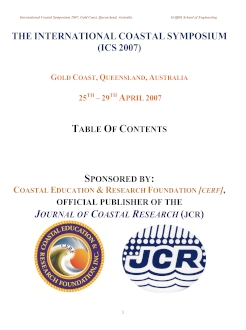Choi, K. H.; Yoon, K. S.; Choi, J. H.; Shin, Y. K.; Lee, J. C.; Suh, M. H.; Munyikwa, K., and Oh, K.H., 2007. Anthropogenic geomorphological changes during the last century in the Kangneung area along the east coast of Korea, Journal of Coastal Research, SI 50 (Proceedings of the 9th International Coastal Symposium), 1015 – 1022. Gold Coast, Australia, ISSN 0749.0208
Geomorphological changes in the Kangneung area along the east coast of Korea were studied through analysis of topographic maps, aerial photographs and sedimentological characteristics of the coastal deposits. Luminescence dating techniques were used to provide depositional chronologies of the sediments. The study area can be classified into various landforms that include beaches, dunes, lakes, rivers, flood plain, coastal terraces and wetlands. Over the last century, among these landforms, Lake Poongho was most seriously damaged and the dune structures were also affected by human interferences. Anthropogenic activities ranging from agriculture to land reclamation and urbanization are the main causes for these changes. In particular, rapid changes were observed in the area in the 1970s with the construction of a huge, coal-fired power plant and the erection of a groyne. Lake Poongho had initially formed at least 2 ka ago when an estuary of the Shidong Stream was blocked by the growth of barriers. At the turn of the century, the dune field was twice its present size, and the foredune was higher than at present. Over the last 90 years, however, the lagoon diminished in size as a result of agricultural activities in the hinterland. During the last 30 years, it almost disappeared completely when coal ashes from the coal fired power plant filled it up. The beach-dune interactions and their landforms have also been affected by other human activities including sand mining, planting of trees, and construction of buildings and groynes. As a result, many slacks and swamps have disappeared and the grain size distributions of the beach and dune sediments are also changing. The results of this study highlight the loss of natural coastal landscapes that date from two thousand years ago as a result of anthropogenic activities which have occurred over the last few decades.





